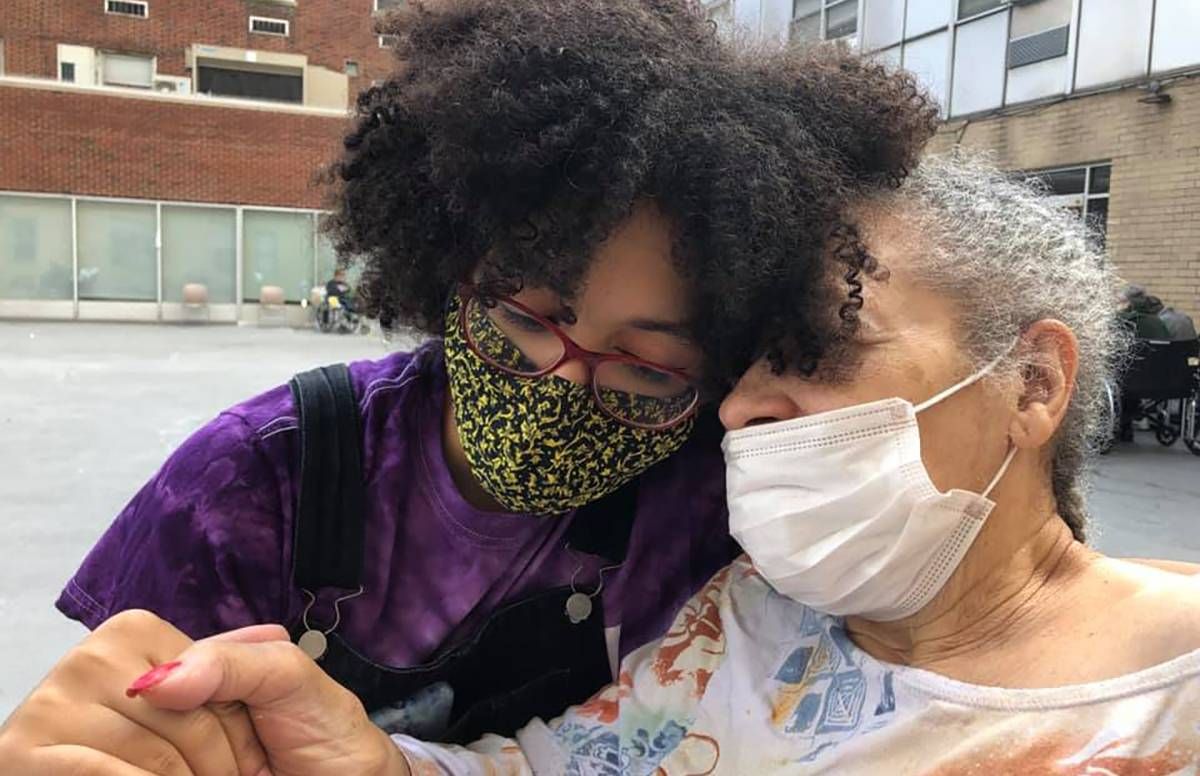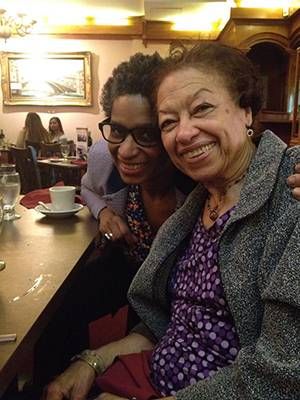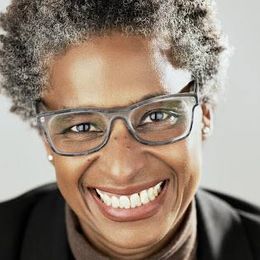'She Was Invincible Until Alzheimer's'
The story of my mother, a Dominican immigrant, and her steady regression with the disease
(Editor's note: This story is part of Taking Care, an ongoing series on the diverse lives of America's family caregivers, with support from The John A. Hartford Foundation.)
I am the daughter of one of the 1.4 million people who live in nursing homes during the pandemic. My mom, Ramona Latty, a Dominican immigrant, has advanced Alzheimer's disease and lives in a nursing facility in the Bronx. She is 88. I am her only living child.

When her nursing home shut down to visitors in March, I called her every week on Skype. I played music, showed her pictures and put my family in front of the screen to wave. For most of the calls, I was met with blank stares and a few words of gibberish. Sometimes she would fall asleep in the middle of the call. She had no idea who I was.
I grabbed her hands. I wanted to protect her.
Every week it got harder to call. It was depressing and so sad. The nursing home would do robocalls letting me know the virus was still there. I had to fight off the worry and stress from overtaking my life.
Who Was Ramona Latty?
Before COVID-19, when I could see her, I would sit in my car before going into the nursing home and remember who she was. She was my beautiful mother who always wore sweet perfume and a charm bracelet that would jingle when she tucked me into bed at night.
My mom would dance disco with me in the kitchen as music blared from the radio. Her hustle was more like a hip-shaking merengue, but that did not stop her from spinning to the beat like a pro. She was the woman I traveled to Paris and Rome with after my sister died in a car accident. My mom had never been to Europe. We could not afford it, but I didn't care. I wanted us to make new memories — and we did.

When I was scared to cross the street in Rome — the cars would not stop speeding by and there was no traffic light — she grabbed my hand and said, "Let's just do it," and we scurried across the street. I was terrified, but we were both laughing. I knew we would be OK.
In my mind, nothing could stop my mom. She was so fearless. She came to this country with nothing and worked so hard in factories and mailrooms so I could live my dreams. She was invincible until Alzheimer's came into our lives.
'Callous Treatment' From Doctors
My mother and I started seeking answers to what was wrong with her about five years ago. I would hold her hand at appointments which took us to waiting rooms that felt like mazes of Black and brown people waiting for doctors who barely seemed to care.
I told her primary care physicians about her hallucinations of a boy in her apartment that were scaring her, but it felt he was more interested in her having knee replacement surgery because her heart was "good." The doctor's office she later went to for neurological testing seemed to care more about getting my participation in a study the physician was doing. When my mother was diagnosed with Alzheimer's disease, the neurologist handed me a list of a few URLs and said "Google it." I grabbed her hands. I wanted to protect her.
The disease is so cruel. And the health care that my mom, countless people of color and others navigate can be cruel, too.
Research shows that Latinos are 1.5 times more likely than non-Latino whites to be stricken by the disease. The health issues that plague our community — high blood pressure, heart disease, diabetes and stroke — make us at a higher risk. The African American community is two to three times more likely to get the disease than its white counterparts.
After the callous treatment so many of us receive at the hands of doctors, it is no surprise that we are not participating in much-needed clinical trials. While Latinos make up roughly 17% of the U.S. population, we make up less than 1% of participants in Alzheimer's clinical trials. Latinos comprise just 7.5% of research participants funded by the National Institutes of Health.
But I was determined to help mom, and so I changed her health care team, and she did get into a clinical trial. The time demands were grueling. Managing her, the drugs and the continuing challenges of the disease completely dominated my life. In the end, she got the placebo.
No Choice But a Nursing Home
My mom's condition continued to worsen, and I had no choice but to place her in a nursing home. Pre-COVID-19 she was stable. She had friends and activities like music and art, and although she was declining, I knew she was safe. But when all activities there ended, she was not allowed to be near her friends, and what was already hard got so much harder.

After seven months of no visits, I was advised by a social worker friend that my mother had to be hospice eligible at this point, and if she was, I could visit. In the time since I had last seen her, my mother had a series of urinary tract infections, her blood pressure had dropped dangerously low and I knew she had been losing weight.
She could no longer walk, speak, feed herself or use the bathroom. The nurse practitioner who had been so helpful to me had resigned, and her replacement would hide behind words like "everything is fine," but I was getting frustrated. I knew my mom was declining at a rapid pace. I asked for the hospice evaluation, and my mother was approved.
'Love Is Our Strength'
I was happy I would get to see her, but the word hospice was hard to process. This meant, to me, that she was literally dying and that this lonely journey had me on a new road that was going to be the hardest one yet. But that is not the case.
A patient can be in hospice and live for years. What hospice did mean was my mom could get more focused care, a nurse who would keep me updated with the truth and — most importantly — I could see her.
I drove the 100 miles to my mom's nursing home with my oldest daughter, Nola, who is 21.
The minute I saw my mom's face, I started crying. And the tears did not stop. We wheeled her to an outside area, and all she wanted to do was hold Nola's hand and stare at her. She giggled and her eyes were smiling. She looked very thin, but so happy. I did not even care that she would not look at me. The tears just keep streaming down my face and onto my mask.
Seeing Nola brought her so much joy. I wondered if she knew who Nola was, as she had not recognized her grandchild in a long time.
Halfway through the visit, as she looked at Nola with so much love in her eyes, my mother said to my daughter, "Yvonne, Yvonne, Yvonne."
My mom thought Nola was me, and in her eyes, I could see how much she loved me. Not even Alzheimer's disease or such a long separation could ever take away the core truth: My mom loves me, I love her and no matter where this journey takes us next — love is our strength.


